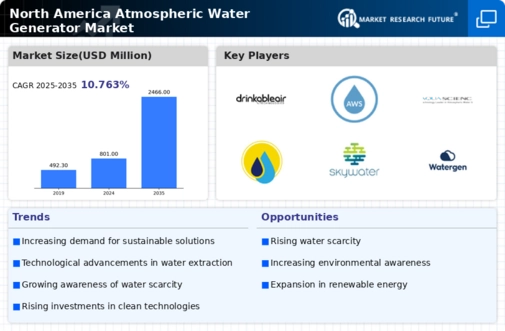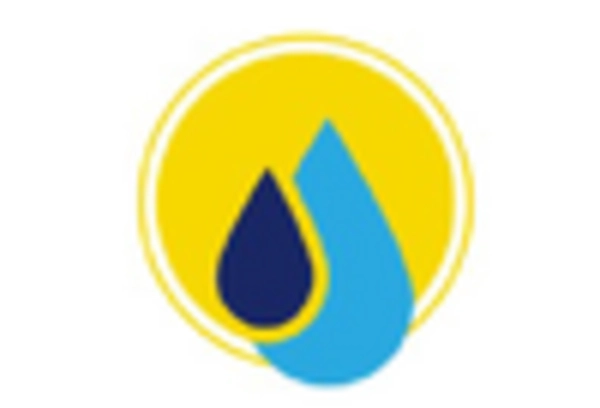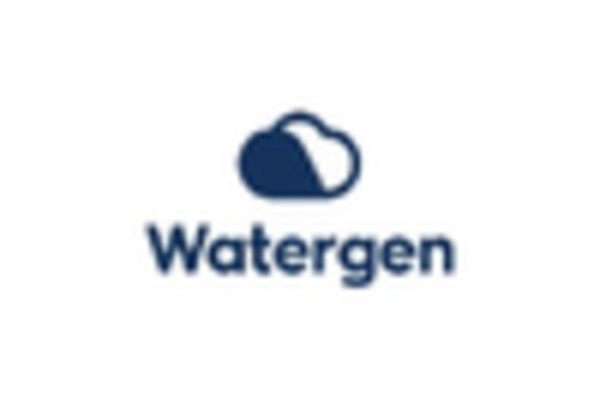Rising Health Awareness
The atmospheric water-generator market in North America is benefiting from a rising awareness of health and wellness among consumers. As individuals become more conscious of the quality of their drinking water, the demand for clean and safe water sources increases. Atmospheric water generators provide a unique solution by producing purified water directly from the air, free from contaminants often found in traditional water supplies. This trend is particularly evident in urban areas where water quality issues are more pronounced. The market is projected to expand as health-conscious consumers prioritize access to high-quality drinking water, potentially increasing sales by 15% annually. This shift in consumer behavior underscores the importance of health considerations in driving the atmospheric water-generator market.
Increasing Water Scarcity
The atmospheric water-generator market in North America is experiencing growth due to the increasing water scarcity in various regions. As climate change continues to impact weather patterns, many areas face prolonged droughts, leading to a significant reduction in freshwater availability. This scarcity drives both residential and commercial sectors to seek alternative water sources. The market is projected to grow at a CAGR of approximately 20% over the next five years, as consumers and businesses alike recognize the potential of atmospheric water generators to provide a sustainable solution. Furthermore, the rising cost of traditional water supply methods, coupled with the need for reliable water sources, positions atmospheric water generators as a viable option for addressing these challenges.
Technological Innovations
Technological innovations play a crucial role in the atmospheric water-generator market in North America. Advances in condensation technology and energy efficiency have made these systems more effective and accessible. For instance, newer models can produce up to 10 liters of water per day while consuming less energy than older versions. This improvement not only enhances the appeal of atmospheric water generators but also aligns with the growing demand for energy-efficient appliances. As consumers become more environmentally conscious, the integration of smart technology into these systems, such as IoT capabilities for monitoring and control, is likely to further drive market growth. The market is expected to reach a valuation of $1 billion by 2027, reflecting the impact of these innovations.
Government Incentives and Support
Government incentives and support are emerging as a significant driver for the atmospheric water-generator market in North America. Various state and local governments are recognizing the potential of these systems to address water scarcity and promote sustainable practices. Initiatives such as tax credits, grants, and subsidies for businesses and homeowners investing in atmospheric water technology are becoming more common. These incentives not only lower the initial investment barrier but also encourage wider adoption of atmospheric water generators. As a result, the market is likely to see increased participation from both residential and commercial sectors, contributing to an estimated market growth of 18% over the next few years. This supportive regulatory environment is crucial for the industry's expansion.
Environmental Concerns and Sustainability
Environmental concerns and sustainability are increasingly influencing the atmospheric water-generator market in North America. As awareness of climate change and its effects on water resources grows, consumers and businesses are seeking sustainable alternatives to traditional water supply methods. Atmospheric water generators offer a solution that utilizes renewable energy sources and reduces reliance on groundwater and surface water. This shift towards sustainable practices is reflected in the market's projected growth, with estimates suggesting a rise of 25% in demand for these systems over the next five years. Additionally, the ability of atmospheric water generators to operate in various climates enhances their appeal, making them a versatile option for addressing water needs while minimizing environmental impact.


















Leave a Comment